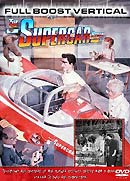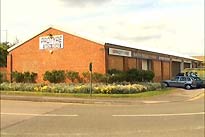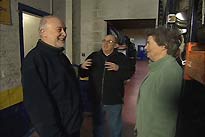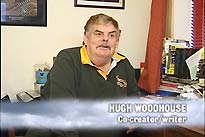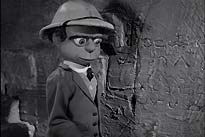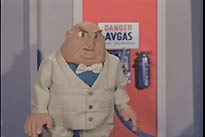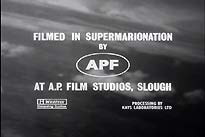|
THE SUPERCAR STORY: FULL BOOST VERTICAL Region 0 (NTSC) Edition - Reviewed by Andrew Foxley Director: Stephen La RiviereFeaturing: David Elliot, Roger Woodburn, Mary Turner, John ReadRemember Virgil Tracy? Troy Tempest and Marina? Captain Scarlet? If you grew up at some point in the past fifty years, there's a decent chance you'll have watched one of the futuristic puppet shows from Gerry Anderson's AP Films stable (later known as Century 21). But whilst Thunderbirds and Captain Scarlet entertain our young even now, the first of the Supermarionation shows, to which these later productions owe a huge debt, is often overlooked. The adventures of Mike Mercury, Jimmy Gibson, Mitch the Monkey and boffins Popkiss and Beaker in their titular vehicle Supercar made for compelling viewing in 1961. The story behind the production of this landmark show is charted in an independently-produced two-disc DVD set, The Supercar Story: Full Boost Vertical. DISC ONE Pleasingly, for a project which would seem to be chiefly of interest to Anderson die-hards, little or no foreknowledge on the part of the viewer is assumed. The documentary is built around a tour of the site of the former AP Films Studios, now a tyre-fitting centre, as David Elliott (director), Roger Woodburn, Mary Turner (puppeteers) and later, John Read (lighting cameraman) share their memories of how the building used to be. An impressive CGI model of the studios was produced especially for the documentary, which is used to help convey exactly what the studios looked like and how certain aspects of production worked. Eric Kachelhofer and his team are to be commended on producing some excellent work, which really helps the documentary come to life, and adds an extra dimension to proceedings.
Indeed, the documentary is a visual treat. Aside from the aforementioned CGI, there's a wealth of behind-the-scenes photos and footage, (much of which is previously unseen), quite aside from the clips from the show itself, which look excellent in all their restored glory. But Full Boost Vertical isn't an example of style over content - the programme is loaded to the gunnels with reminiscences and anecdotes from twenty interviewees, some of whom have never talked about their work on the series before, so there's quite a bit of fresh information to be found here. Together their recollections help to build up a fascinating picture of what working on the series was like. The generally positive and upbeat tone of many of the contributors makes for enjoyable viewing. This is very much a story of the production from the studio floor, chiefly concerned with the nuts-and-bolts of production, and invoking a tremendous feeling of nostalgia. Neither Gerry nor Sylvia Anderson take part in the documentary, although their presence is not actually missed, so interesting are the many participants. David Graham is particularly entertaining, especially when he proves he can manage a pitch-perfect recreation of Mitch the Monkey's screeching more than forty years later! The documentary is presented in two parts, complete with a commercial break, which offers an opportunity to see some rare Supercar-themed advertisements. Each of these is broken down into sub-sections tackling a different aspect of the show and its production. Although the total running time is just short of two hours, the production never feels over-stretched or dull. All credit is due to director / producer Stephen La Riviere and the production team for producing a meticulously-researched and consistently fascinating piece of viewing. This is highly recommended, to both die-hard fans who thought they'd heard everything about the show, or to anyone who's just a little curious about this first foray into the world of Supermarionation.
DISC TWO The second disc offers a selection of rare bonus material - largely archive material which has found its way into the documentary in some form, but which is presented here in its entirety. The Behind the Scenes section offers some interesting footage: 35mm film rushes for both the show's opening and closing credits. This is interesting to see, even if the novelty might wear off for all but the most die-hard fans after a while. Still, it's nice to see it here in its entirety. Far more fascinating is AP Films Studio Walkthrough, a six and a half minute featurette narrated by Alan Pattillo, which presents the full version of the CGI walkthrough footage seen in the documentary together with behind-the-scenes photographs to provide an excellent overview of the studios. The Title Sequences section is, unsurprisingly, a collection of various versions of the Supercar title sequence. We have a French version, a Spanish version, a sound-effects only version (sans the theme tune), and a set of blank titles without captions. Of these, the most entertaining would have to be the foreign language titles, largely due to the fact that they feature rare French and Spanish versions of Barry Gray's theme song. There's also the original intermission card. Audio Features presents a pair of contemporary audio adventures. One is Sabotage, a short promotional flexidisc adventure created for National Benzol. Although scarcely four minutes long, it's almost excruciating to listen to - basically an extended advertisement for the company concerned featuring the Supercar team. The second is Flight of Fancy - a forty-five minute LP which is very much a precursor to the famous TV21 Mini-Albums. Although based upon one of the TV show's weaker episodes, and with a pace that could be described as pedestrian at best, it's still well worth a listen in a 'so bad it's good' kind of way. Although neither of these could be described as essential, it's still nice to hear them, as they're very unlikely to see any kind of release anywhere else. The DVD boasts extensive photo galleries, featuring many photographs that have never been seen before - both black and white and colour (although very few colour photo’s from the series exist). There are behind-the-scenes shots, publicity shots, merchandise shots, even a set of Viewmaster pictures featuring Supercar and the team. But perhaps the most impressive part of the extras package is labelled Supercolour Scenes. A brief piece of colourised footage from the documentary (from The Tracking of Masterspy) turns up again, along with a scene from Crash Landing. Leaving aside the thorny issue of whether it is right to colourise black and white footage, these clips do offer an excellent opportunity to get a look at the puppets in action, just as they would have been in the studio. It's also the best example I've seen of colourising film from scratch. There's an extra bonus in this section, though - a presentation of the Fireball XL5 footage that was colourised as part of a test several years ago. Commercially unavailable until now, this is quite wonderful - an excellent job was done on the footage, and it's a fanboy's dream to see Fireball XL5 take off in colour for the first time. The package also boasts a full-colour booklet, which sets the documentary in context, provides an index of participants and offers a full episode listing (with writer / director credits and TX dates and times). All in all, the double-disc set as a whole makes the most of an opportunity to present a lot of rare material which is unlikely to see the light of day on any commercial release. Whilst much of the material on the second disc finds its way into the main feature in one form or another, it's great to see this footage presented in its own right - a treasure-trove of rarities for Supercar fans, and one that's long overdue!
|
||||||||||||||||


